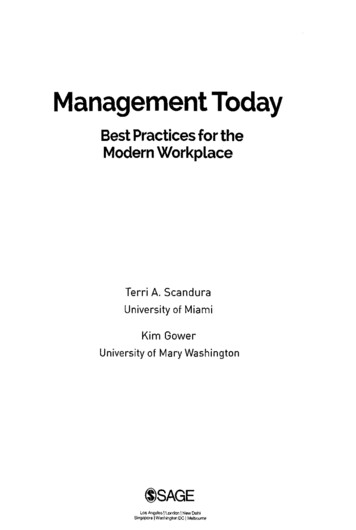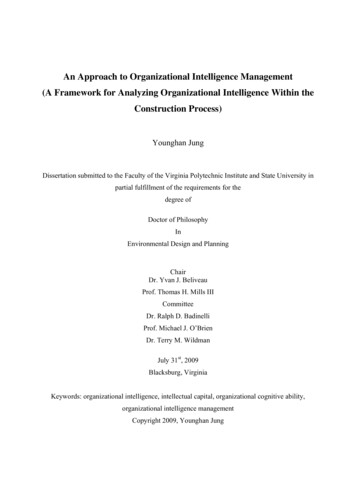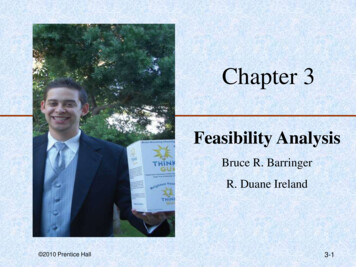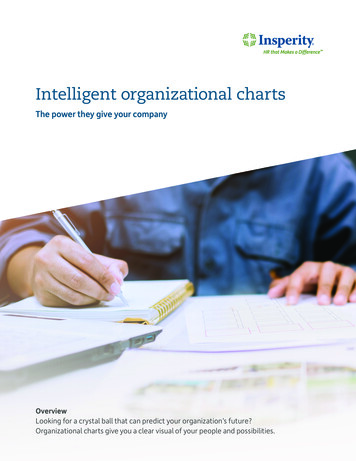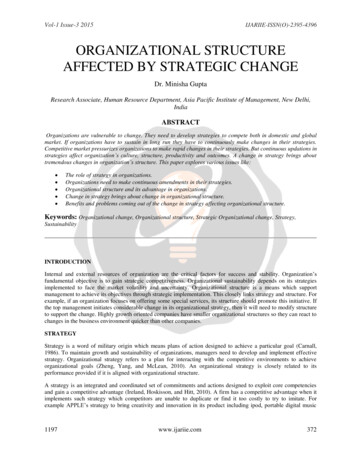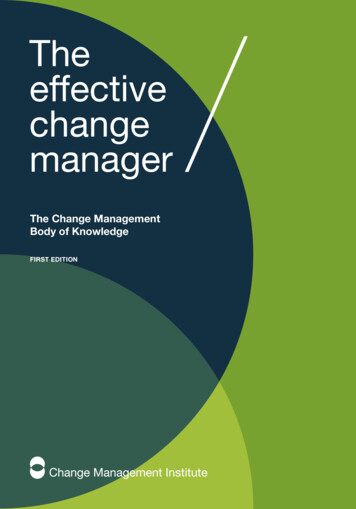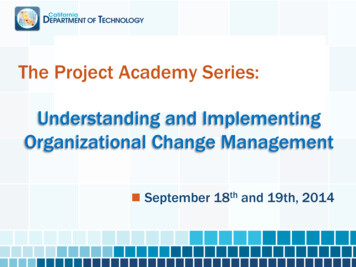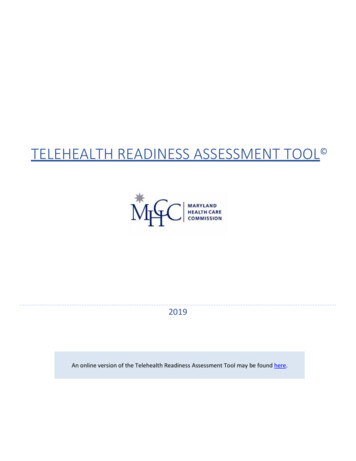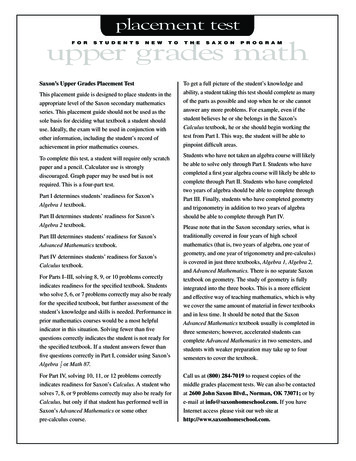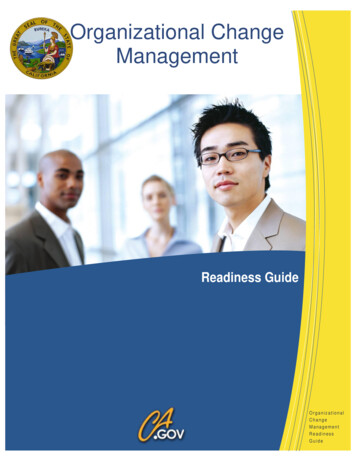
Transcription
Organizational ChangeManagementReadiness GuideOrganizationalChangeManagementReadinessGuide
How This Guide Will HelpKICKSTART YOUR READI NESS FOR CHANGE!This guide provides California State departments a practicaloverview of Organization Change Management (OCM) to helpprepare your organization for change during transition. The guidefocuses on key concepts that help you ready your department fororganizational change. Any size project at any size organization.The pillars of change in this guide and accompanying tools helpyou mature your organizations readiness for change.These next few pages provide descriptions, tools and templatesanchored to the five pillars of change; Communication, Readiness,Sponsorship, Stakeholder Management and Training. Take theReadiness Assessment to evaluate your organization’s readinessfor change and focus on the key areas that will prepare yourorganization for successful change. Assess your readiness now!“WE NOW ACCEPT THE FACT THAT LEARNING IS A LIFELONG PROCESSWhere Do I Start?RIGHT HERE!OF KEEPING ABREAST OF CHANGE. THE MOST PRESSING TASK IS TOTEACH PEOPLE HOW TO LEARN.” – PETER DRUCKERWhat is OCM?To kick off your readiness for anyIT’S ABOUT THE PEOPLE, PEOPLEchange project, follow these threesteps:Organizational Change Management (OCM) is an approach totransitioning an organization, its groups and individuals from their1. Complete the Readiness Assess- current state to a new state. It helps an organization integrate andment included in this guide.align people, processes, culture and strategy. It is all aboutmanaging the most important part of change.the people. The2. Review your score and recommen- more mature an organization’s change management ability thedations.more comprehensive, structured and cyclical the change processwill be. This helps an organization implement change strategically,3. Follow the recommendations for dynamically and ultimately more successfully.your organizational readiness planning. The topic of OCM is massive, complex, varied and can beGet Ready for Change!intimidating. But like anything else, with some research, hardwork, team effort and a great attitude you will be well on your wayto managing the changes your organization needs to make yournext project a success!OCM That Fits YouThe size and complexity of both your project and your organizationdetermines the components of change you should include in yourOCM approach. The Five Pillars of Change are explained on Page5 but this list shows what pillars you need to concentrate on for yourupcoming project size and type.1Small / Simple / Transactional ProjectCom m unic a tion - Spo n s ors hipMedium / Operational Change ProjectCom m unic a tion - Spons ors hip -Sta k e h olde r M a na ge m e ntLarge/ Complex / Transformational ProjectCom m unic a tion - Spons ors hip -Sta k e h olde r M a na ge m e ntRe a dine s s - T ra ining
Readiness AssessmentH O W R E A D Y A R E Y O U F O R C H A N G E ? W H A T C A N Y O U D O T O I MP R O V E ?Instructions:This Readiness Assessment assists you in evaluating your readiness for change. It may beused in several ways:1. Self-evaluation, as a way to validate intuitions and feelings about how ready your organization is for change.2. Hand out the assessment and use it as a discussion topic with the management or workgroup teams.3. Solicit reviews from staff and ask for honest answers, protecting confidentiality. Shareresults with project stakeholders, such as implementation and business change managementteams.Assessment Scoring1. Project Manager/Change Manager leading the change effort should take this assessmentfrom an organization perspective, not from his/her individual perspective.2. Average Score is calculated at each pillar of Organizational Change Management via thisReadiness Assessment.3. Average score below 4.0 for any of these categories indicates that organization is notfully prepared and should spend efforts based on the guidance from that particular section ofthe guide.4. For each question, in the column to the right, enter the number that best representsyour organization’s ability to manage change. Responses are interpreted as follows:1 Strongly Disagree, 2 Disagree, 3 Neutral,4 Somewhat Agree, 5 Agree, 6 Strongly AgreeCommunication - Informing who is affected and impactedregarding the change.1The organization has a clearly defined vision and strategy and changes arecontinually communicated with all stakeholders.2Priorities are set and continually communicated regarding change projects andother competing initiatives.345Response:(Enter aNumberbetween 1and 6)The organization uses multiple communication methods to keep stakeholdersinformed.The organization’s messaging about change projects is clear, concise andconsistent.Mechanisms are in place to identify lapses in effective communication.Total Communication Score / 5 Average Score2Communication is the foundation and mechanism to build positive organizational change.For more information, tools and templates for developing a solid communication strategy foryour change effort see Page 5 Pillar #1: Com m un ic a tion .
Readiness AssessmentCONTINUEDSponsorship - Ensuring there is active sponsorship for the changeat a senior executive level within the organization, and engagingthis sponsorship to achieve the desired results.6Change initiatives in the organization have an executive sponsor identified.7The executive sponsor has the necessary authority over the people, processesand systems to authorize and fund change initiatives.8The executive sponsor can build awareness of the need for change (why thechange is happening).9The executive sponsor will actively and visibly participate with the project teamthroughout the entire change process.10Response:(Enter aNumberbetween 1and 6)The executive sponsor will resolve issues and make decisions relating to thechange project schedule, scope and resources.Total Sponsorship Score / 5 Average ScoreStrong, Supportive Sponsorship can make or break a large scale change initiative.Having an engaged, active sponsor is critical to success. For more information, tools andtemplates for this pillar of OCM see Page 5 Pillar #2: S pons ors h ipStakeholder Management - Gaining buy-in for the changes fromthose involved and affected, directly or indirectly. Involving theright people in the design and implementation of changes, tomake sure the right changes are made.11The executive sponsor is willing and able to build a sponsorship coalition forchange, and is able to manage resistance from all stakeholders.12Change is managed effectively and change successes are celebrated, both inprivate and in public.13Stakeholders hear a consistent and unified message from various levels of executives.14Change initiatives are accurately tailored to the particular needs and concerns ofeach stakeholder group.15Special tactics have been developed for handling resistance to change fromvarious stakeholders.Response:(Enter aNumberbetween 1and 6)Total Stakeholder Management Score / 5 Average ScoreStakeholder Management is the effort to engage key players of your change effort earlyand consistently during the change cycle. Identifying and managing these relationships oftendirectly correlates to the success of the change effort. For more information, tools andtemplates see Page 6 Pillar #3: S ta k e holde r M a na g e m e nt3
Readiness AssessmentCONTINUEDReadiness - Getting people ready to adapt to the changes byensuring they have the right information and toolsets.16A structured change management approach is being communicated and appliedto change projects.17Change management team members have been identified. Managers and staffare trained on Organizational Change Management.18Project team and change management teams are tracking progress and able toresolve related issues through set project management processes. A projectplan has been integrated with a change management plan.19Resources for change projects are identified and acquired based on a projectplan. Resources have the necessary time to complete work for the change.20Feedback processes are continually used to determine how effectively change isbeing adopted by stakeholders.Response:(Enter aNumberbetween 1and 6)Total Readiness Score / 5 Average ScoreReadiness is the benchmark of successful change. This pillar puts it all together, organizational readiness is about getting an entire group and culture to accept and move forwardwith change. For more see Page 6 Pillar #4: Re a d ine s s & Page 8: Re a din e s s i n De ta i lTraining - Training the appropriate resources on the change21Organization recognizes and reinforces skills and behaviors required for thechange effort.22Skills and knowledge needed for transition have been identified.23Skills assessments are continually conducted for change projects and gaps areidentified for transition.24Training is developed and scheduled proactively, based on gaps and need assessments.25Flexible methods are employed for training i.e. Web Based, Webcasts, Guides,In Class training etc.Response:(Enter aNumberbetween 1and 6)Total Training Score / 5 Average ScoreTraining is recommended to understand gaps in skills and provide opportunities to learnnew ways of doing business before a change is implemented. For more information, toolsand templates regarding training for your change effort see Page 7 Pillar #5: T ra in ing4
The ER -1. CommunicationCommunication is the fundamental pillar of change. People crave information and want to know what isgoing to happen, how, when and why! It is the engagement mechanism for change. Communication helpsyou frame how your stakeholders are exposed to the change and thereby gives you the avenue forinfluencing how they view it. Without quality communication your change participants will not have theawareness and understanding they need to commit to and implement your change successfully. Byformally setting expectations, employing tools to improve communication and proactively seeking ways toreduce misinformation, stakeholders are more likely to buy into a change initially. They will also stay morecommitted to the change, ultimately leading to a successful transformation. Good communication shouldbe deliberate and well thought out. Develop your communication strategy in the early stages of planningthe change itself. Communicate early, openly, often, through multiple methods and allow for feedback.Idea: To build on your communication planning for change, review the section titled “Readiness inDetail”. Ensure an adequate communication plan and overall strategy is established for yourchange effort and confirm communication is flowing at all levels in your organization.Communication Tools and TemplatesUSE THESE RESOURCES TO GET STARTED TODAYCategoryChecklistWorksheetTemplateArtifact DescriptionLink to the ArtifactCommunication -checklistcommunication.htmCommunicating a Compelling Vision for mmunicatingCompelling-Vision.docxCommunications Plan CommunicationsPlan.doc2. SponsorshipWhen change occurs people turn to the organization’s leaders for direction and support. Ensure there isactive sponsorship for the change at an executive level within the organization, and engage thissponsorship for a successful outcome. A sponsor builds commitment across the organization andparticularly at the senior management level.Sponsors have ultimate responsibility for projects. Success of a project can be directly linked to an activesponsor who champions the change, mitigates change resistance and builds organizational alliances.Idea: To build on your sponsorship of change, validate thatthe level of your primary sponsor matches up with the sizeand type of the change. Determine if the change has theright level of sponsorship before moving ahead.Sponsorship Tools and TemplatesUSE THESE RESOURCES TO GET STARTED TODAYCategory5ChecklistToolArtifact DescriptionLink to the ArtifactSponsorship -checklist-sponsorship.htmOCM Change /21/OCM-Change-Leadership-Review.doc
SuccessfulChange··MANAGEMENTREADINESSTips and TricksTRAINING3. Stakeholder ManagementThe primary goals of Stakeholder Managementare to accurately identify all stakeholders andmake them aware of the change and its benefitsthroughout the change process. This helps gainand maintain stakeholder buy-in. Much likeSponsorship, actively engaging stakeholdersearly during the change cycle often directlycorrelates to the success of the change. Perform change activities with stakeholders, not ‘to’ them. Commit to a partnership with your stakeholders. It is absolutely critical that those impacted by the change understand the needsfor and benefits of the change.Once you have identified and planned a strategy to engage your stakeholders, askyourself what else is going on in the organization and what could distract them.Ensure you are able to focus your stakeholders on the change. Strategize and tailoryour messaging to the types of stakeholders on the project.Communication Create a strong, centralizedvoice for policy and programcoordination, development,implementation and monitoring Conduct individual businessmeetings and brown-baglunches with various businessunits to identify concerns andproblem areas prior to the transition Have on-site representationduring the transition time periodIdea: To build on stakeholder management, conduct a stakeholder analysiswith your leadership team. Ensure this analysis is continually revisited andrefreshed. Too often, stakeholders are replaced with others that may have adifferent agenda. Effective stakeholder management provides you the toolsto look ahead and anticipate problems before they happen.Stakeholder Management Tools and TemplatesUSE THESE RESOURCES TO GET STARTED TODAYCategoryArtifact DescriptionLink to the ArtifactWorksheetDeveloping a Strategy to Deal withPeople’s Response to eloping-A-Strategy.docToolOCM Job Duty M-Job-DutyAssessment.docToolOCM Gap Analysis WalkthroughWorksheetToolOCM Stakeholder MapToolStakeholder d/pdf/itla/21/OCMStakeholder-Analysis.docx4. Readinessto answer staff questions andaddress concerns/issuesSponsorship Engage your executive leadership sponsors to create a strongcentralized voice to share thevision (policies and processchanges, timelines for change,benefits of change) Get sponsor buy-in and agreementStakeholder Mgmt. Tailor your messaging to theThis is a measure of the reality of the currentorganization in relation to the future state. Whendetermining readiness for change you should considerthe culture and history of change in your organization,accountability, resource availability, and availability ofstaff with change management knowledge andexperience. There are two perspectives by whichreadiness is assessed:1. The human side of change. Supporting the peopleand culture involved in the change.Continued.types and styles that mostimpact your stakeholders. Create a decision makingframework for the leadershipteam to use to engage andmake decisions with stakeholders.6
The Five Pillars of Successful Change.Readiness Continued2. It is necessary to document and understand the organizational processes impacted bychange. This readies you to migrate from “current state” to “future state” processes.Business Process Modeling allows you to identify processes impacted by the new system,create a baseline for process improvements, increase efficiency in day-to-day operations,educate staff and advance business understanding. See the Business Process ModelingGuide or BPM Quick Start Guide in your packet for more information.The first perspective is about getting people ready to adapt to change by ensuring they have the rightinformation and toolsets. It is covered more in the Readiness In Detail section on the next page.Idea: To build on your readiness, review the section titled “Readiness in Detail” and follow steps 1thru 5. Ensure you are prepared by advocating a holistic approach to the change effort with yourleadership team.Readiness Tools and TemplatesUSE THESE RESOURCES TO GET STARTED TODAYCategoryWorksheetArtifact DescriptionLink to the ArtifactPlanning for 1/OCMPlanning-For-Implementation.doc5. Training and TurnoverThe primary goal of Training in OCM is to understand gapsin stakeholders’ skills and provide them opportunities tolearn these skills before the change is implemented. Alearning solution should be designed to fosterunderstanding, acceptance and commitment, enable allusers to work with, and build their confidence in the newprocesses/systems. Additionally, turnover is a “hidden” costof change management. Staff turnover is often prevalentand disruptive during a major change effort and can resultin reduced employee morale and retention. Engaging staffearly and providing adequate training and communication about the change is essential to demystifyrumors and opposition in your organizational change initiative. Training and knowledge transfer / skillbuilding will help ensure that your staff have the necessary technical and business knowledge, skills, andabilities to successfully navigate the changes of your project.Idea: To build on training in your organizational management strategy, educate your leadershipteam and change agents in organizational change management methodologies such as ADKAR, aswell as the specifics on the change itself. Additionally, to ensure you have planned adequately forstaff turnover, create a transition plan that can set the stage for new employees.Training Tools and TemplatesUSE THESE RESOURCES TO GET STARTED TODAYCategoryTool7ToolArtifact DescriptionOCM ADKAR AssessmentTool ReferenceLink to the DKAR-Assessment.docSCO Generic DepartmentalFI Cal Transition Generic-Departmental-Transition-PlanDRAFT.docx
Readiness In DetailW H A T Y O U C A N B E D O I N G NO W T O G E T R E A D Y F O R C H A N G E ?Tips and TricksAll five of the change pillars provide insight into the areas of focus for a large scalechange to be successful in your organization. So now, what? You know what to focuson, but what can YOU be doing to get ready for change right now?Step 1: Assess Your Organization Change Readiness.Review the assessment results from this guide. If the assessment was taken individually, get your leadership teams and sponsors together and review the results. If you can,vet the assessment with a third party to assist with measuring your change readiness.This could be a vendor or a different area within your organization.Questions to keep in mind when assessing your OCM Readiness Level How well does your organization function during change efforts? How well positioned is the organization to be able to absorb all the changes planned withoutcreating significant risk of overload in affected areas?Readiness Complete the ReadinessAssessment Conduct Business ProcessModeling(BPM) See BPMQuick Start Guide If you have a Gartner subscription: ITScore for Business Process Management,2013 What are the resources involved and what is their degree of skills and experience? What is your leadership’s capability of sponsoring and supporting change? What generates desire for the change and what creates resistance to it? What do you need to improve support and reduce roadblocks for the change? What is your corporate culture and historical experience in dealing with change?Training Ensure you haveplanned adequately forstaff turnover, create aStep 2: Select an OCM Methodology.transition plan that canBecome acquainted with change management techniques and select a methodologyfor your change project. Use a blend of techniques to best address your organization'sculture and specific project needs. There are many to choose from, refer to the “DiveDeeper” section for several methodology selections and resources. Many CaliforniaState departments are using Prosci’s ADKAR training for their leadership teams.set the stage for newemployees Identify roles, skill building requirements, training classes and establish a comprehensiveStep 3: Start Planning, Select your Team Size & Strategy.Discuss the information in this guide with your leadership team and develop a charterand communication plan for the change effort. Be prepared for a significant workloadadjustment and priority discussion. Plan to spend 10-20% of your project budget onreadiness planning. Select team size and strategy. Identify and ensure legacy andkey subject matter staff are assigned as change agents for managing resistance.Involve people from all areas of the organization. Plan early and embrace thechange. Communicate consistently at all levels of your organization including thebenefits and “WIIFM” (What’s in it for me?)”. Implement ways to measure readiness.training planOCM Methodologies PROSCI / ADKARhttp://www.prosci.com/ 4 Change Mgmt. Strategieshttp://www.nickols.us/four strategies.pdfStep 4: Review the Business Process Modeling (BPM) Guide.Remember that there are two perspectives to readiness. For the systems and processes perspective there is a separate guide in your packet. The Business ProcessModeling (BPM) Guide teaches you a repeatable process to identify as-is businessprocesses and provides guidance for assessing your readiness for process change.Create a baseline for process improvements. Identify ways to increase efficiency inday to day operations. Get started now by reviewing the BPM Guide included in thispacket.Step 5: Translate the Vision for Change into Reality!Carry out your plan! Embrace the change. Communicate consistently at all levelsof your organization including the benefits and “WIIFM” (What’s in it for me?)”.Implement ways to measure readiness. Make Change Stick! (Kotter). Change Management 101http://www.nickols.us/change.pdfAnd Remember Celebrate your successes Keep the organization motivated during challenges8
Stages of ChangeGENERATE AWARENESS AND GAIN COMMITMENTYou know that the change needs to happen, but you don't really know how to go about delivering it. Wheredo you start? Whom do you involve? How do you see it through to the end? Begin your OCM programearly. Using a time based approach to provide the right information, to the right people, at the right time,in the right way. The Stages of Change maps the process of awareness, understanding, acceptance andcommitment to the phases of a project’s lifecycle. In the planning phase of your project generateawareness about the change, providing project specific information and explain the goals and purpose ofthe change. In the design phase help people understand the impacts of change by communicatingdecisions made and informing people how they will work with the change.During the build/test phase of your project communicate the changes to the impacted business processes,clarify roles, discuss the implementation approach, determine training needed to build the skills required,communicate the timeline and planned rollout activities. Also, during the deployment and transition phaseinform stakeholders of key milestones, provide ongoing support processes, encourage participation,celebrate successes and communicate issues and resolutions timely. Make continuous efforts to ensurethat the change is seen in every aspect of your organization. This will help give that change a solid placein your organization's culture.Stages of Change - FI Cal Change Management Office Wave 2 Kick Offhttp://www.fiscal.ca.gov/documents/W2 Analyze Kickoff forDepts v2.pdfMake Change Stick!FOLLOW THROUGH AND SUSTAIN CHANGE9One of the greatest challenges with any change initiative isfollowing through and sustaining the change. It is too easy foran organization to fall back into old habits. Remember, ittakes time and diligence to change organizational behavior.Clear, consistent, positive reinforcement of desired behaviorsis the best way to effect a change in the way people dothings.To sustain the change, you need to use positive reinforcement of the new habit continues long after the initial change is completed. Be ready to implement and reinforce thatnext big change. Avoid the “One and Done”, Make Change Stick!
Dive DeeperOCM REFERENCES, YOU CAN’T READ JUST ONEBelow are some resources and best practices material for your organization todive deeper into the subject of Organizational Change Management.Gartner Reference Materials (www.gartner.com) Organizational Readiness Guidelines for BPM Getting started With BPM, Part 1: Assessing Readiness Getting Started With BPM: Are You Ready? 10 Best Practices in Organizational Change for Project Managers Gartner IT Score*Subscription to Gartner for IT Professionals required.Maturity Assessments and Models Who’s Ready for Whole System Change? - http://proactionassociates.com/site ProAction/section publications/PDFs/PRO article WhosReadyChangeReadinessChecklist.pdf OCM Maturity— ity%20-%20Feb%202012 1.pdf Prosci OCM Maturity ogy Research and OCM Best Practices Research Prosci / ADKAR http://www.prosci.com/ Free Management Library http://managementhelp.org/ Four Change Management Strategies http://www.nickols.us/four strategies.pdf Change Management 101 http://www.nickols.us/change.pdfChange Management LiteratureKotter, John P. Leading Change. Boston, MA: Harvard Business School, 1996. Print.Conner, Daryl. Managing at the Speed of Change: How Resilient Managers Succeed and Prosper WhereOthers Fail. New York: Villard, 1993. Print.Bridges, William. Managing Transitions: Making the Most of Change. Reading, MA: Addison-Wesley, 1991.Print.Change Management Training Prosci ADKAR Training is available at College of Continuing Educationand Sacramento State: www.cce.csus.eduOCM Templates and Maturity Audit Packages (For Purchase) Prosci CM Pilot Professional http://www.change-management.com/cm-pilot.htm Prosci Maturity Model Audit http://www.prosci.com/ecm1/maturity-audit/OVERALL READINESS TO OLS FOR YOU TO GET STARTED TODAYCategoryArtifact DescriptionLink to the ArtifactWorksheetLeading People Through ading-People-ThroughChange.docxAssessmentReadiness Assessment—MS WordAssessmentReadiness Assessment—MS ExcelGuideBusiness Process Modeling diness-Guide-v1.PDFGuideBusiness Process Modeling Quick nt.xls10
Stephen AdamsElizabeth BourrageJeanette BrazilDenise BrowneGary CannonJessica ChinJoy GuzmanJacob JohnsonLaura KleinSuzanne McBrideJacquelyn MooreTim PaulsenMary ShearManpreet SidhuDavid WilliamsPatrick YimThe Information Technology Leadership Academy is a year-long program for state IT managers with a focus on developingleadership skills. Participants in the academy are selected candidates from state agencies and departments that work in informationtechnology programs. Individuals with a vision for enterprise-wide thinking, strong potential for career advancement, and experiencecarrying out their organization’s mission and vision are ideal candidates for acceptance into this program.Version 1.1October, 17, 2014
Total Stakeholder Management Score / 5 Average Score Readiness Assessment CONTINUED Stakeholder Management is the effort to engage key players of your change effort early and consistently during the change cycle. Identifying and managing these relationships often directly correla
